- Knowledge and Education
- Popularizing Knowledge
- Source (2/18)
Johann Amos Comenius, Orbis Sensualium Pictus (1658)
Abstract
Johann Amos Comenius (1592-1670) was a Czech educational theorist whose ideas anticipated the naturalistic education of the later eighteenth century. He was also a bishop in the Bohemian Brethren Church, a Protestant denomination rooted in the theology of Jan Hus. This bilingual (Latin-German) textbook for children was immensely popular and was translated into many European languages. A Latin-English version appeared in 1659.
Source
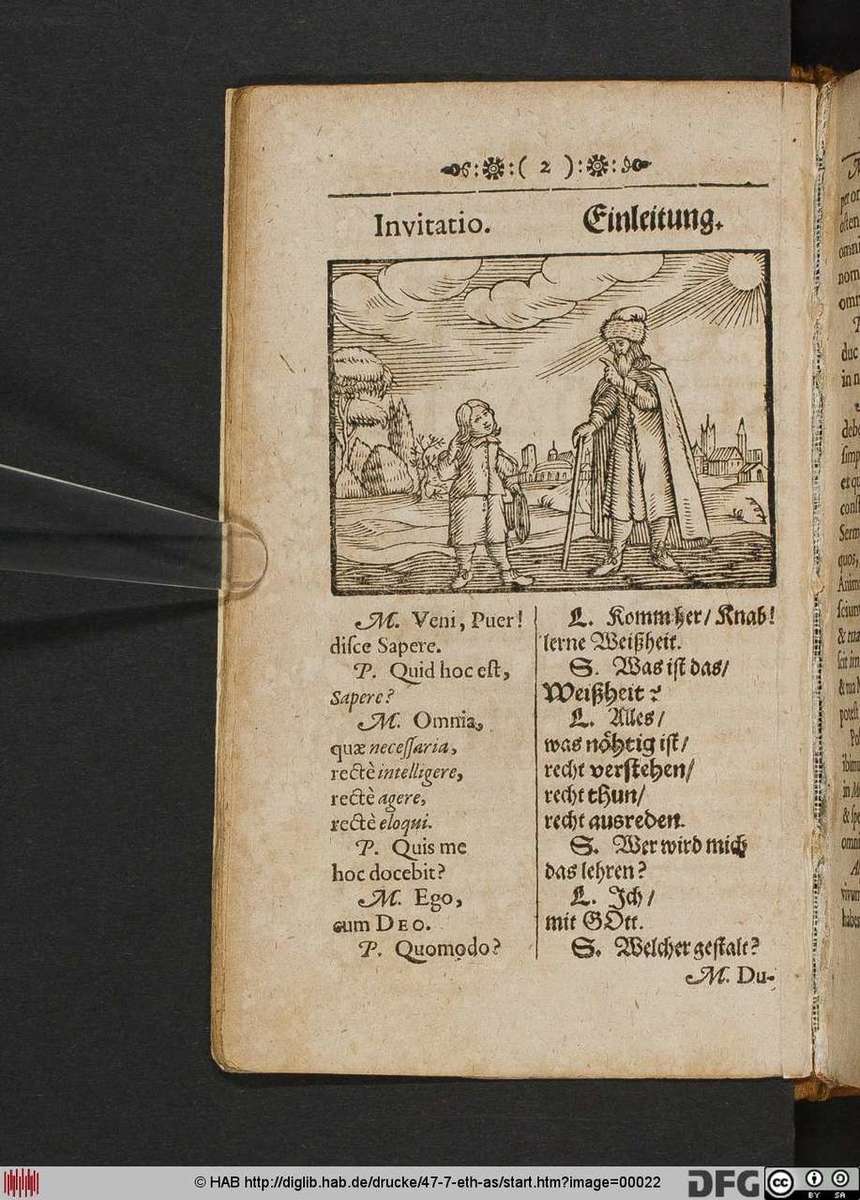
Invitation
Master and the Boy.
M. Come, Boy,
learn to be wise.
P. What doth this mean,
to be wise?
M. To understand rightly,
to do rightly,
and to speak out rightly
all that are necessary.
P. Who will teach me this?
M. I,
by God’s help.
P. How?
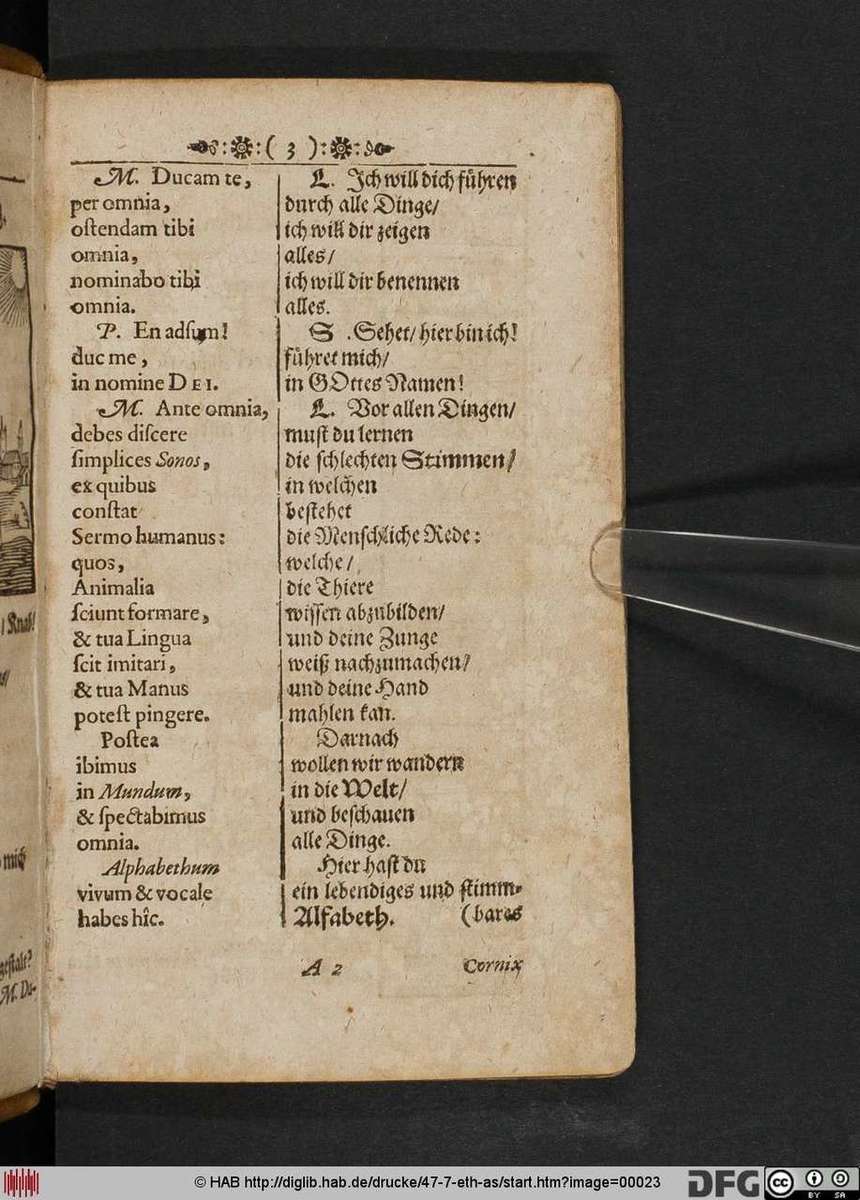
M. I will guide thee thorow all.
I will shew thee all.
I will name thee all.
P. See, here I am;
lead me in the name of God.
M. Before all things,
thou oughtest to learn
the plain sounds,
of which man’s speech
consisteth;
which living creatures
know how to make,
and thy Tongue knoweth how
to imitate, and thy hand
can picture out.
Afterwards we will go
into the World,
and we will view all things.
Here thou hast a lively
and Vocal Alphabet.
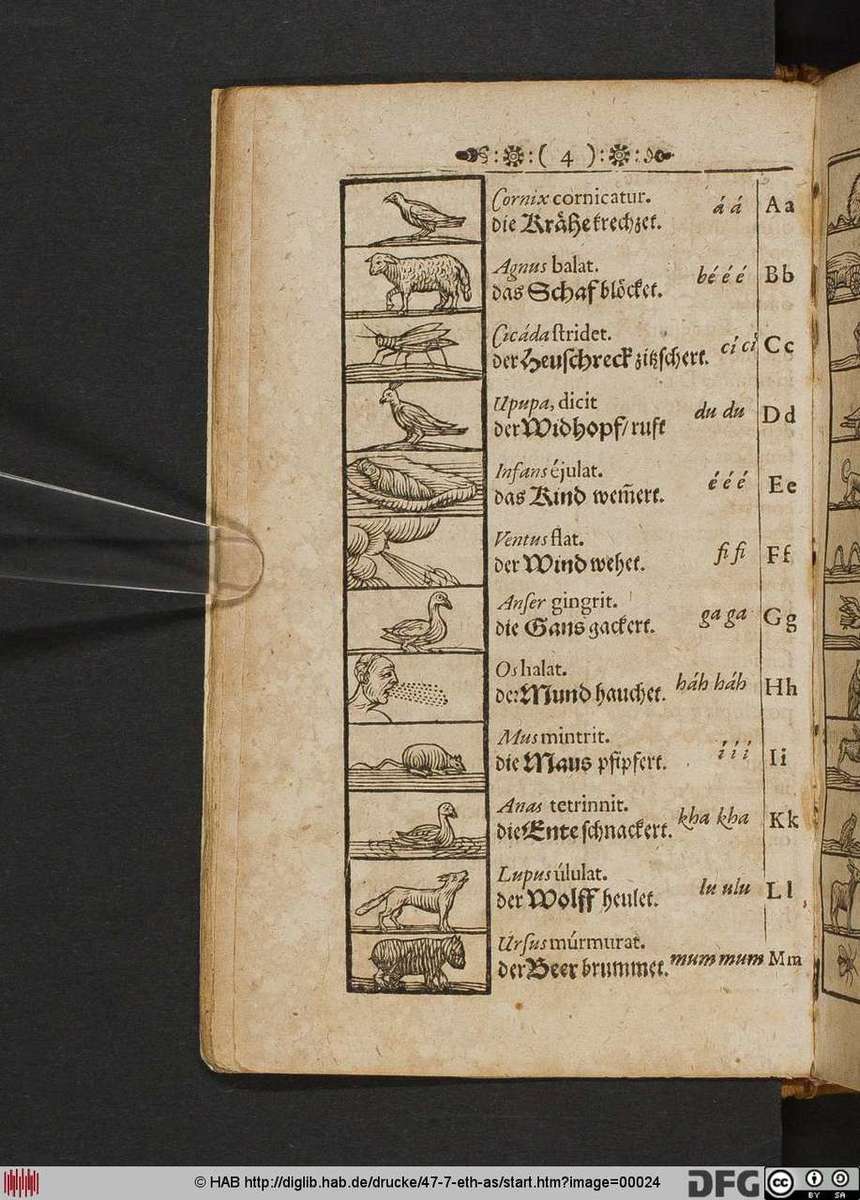
Cornix cornicatur.
The Crow crieth. à à / Aa
Agnus balat.
The Lamb blaiteth. b è è è / Bb
Cicáda stridet.
The Grasshopper chirpeth. cì cì / Cc
Upupa, dicit
The Whooppoo saith. du du / Dd
Infans éjulat.
The Infant crieth. è è è / Ee
Ventus flat.
The Wind bloweth. fi fi / Ff
Anser gingrit.
The Goose gagleth. ga ga / Gg
Os halat.
The Mouth breatheth. hà’h hà’h / Hh
Mus mintrit.
The Mouse chirpeth. ì ì ì / Ii
Anas tetrinnit.
The Duck quaketh. kha kha / Kk
Lupus úlulat.
The Wolf howleth. lu ulu / Ll
Ursus múrmurat.
The Bear grumbleth. mum mum / Mm
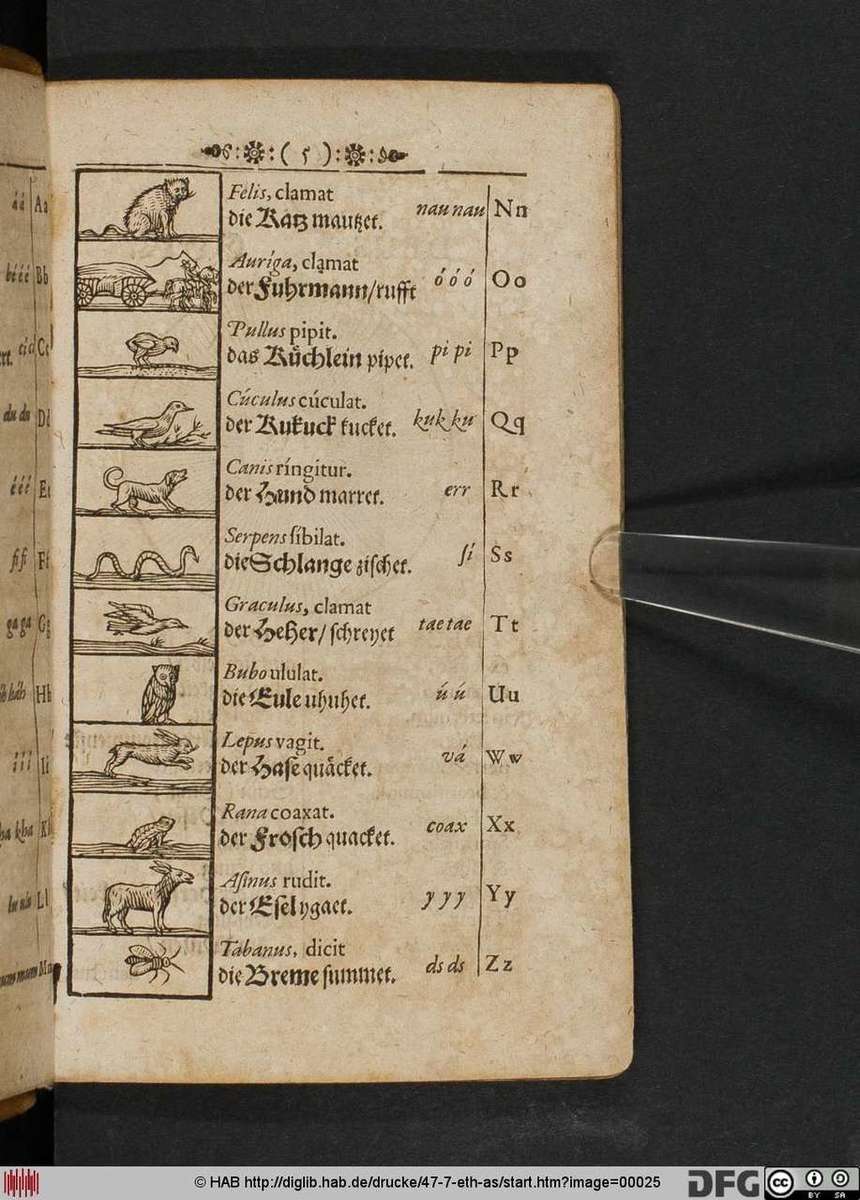
Felis, clamat
The Cat crieth. nau nau / Nn
Auríga, clamat
The Carter crieth. ò ò ò / Oo
Pullus pipit.
The Chicken peepeth. pi pi / Pp
Cúculus cúculat.
The cuckow singeth. kuk ku / Qq
Canis ríngitur.
The dog grinneth. err / Rr
Serpens síbilat.
The Serpent hisseth. si / Ss
Graculus, clamat
The Jay crieth. tac tac / Tt
Bubo ululat.
The Owl hooteth. ù ù / Uu
Lepus vagit.
The Hare squeaketh. va / Ww
Rana coaxat.
The Frog croaketh. coax / Xx
Afinus rudit.
The Asse brayeth. y y y / Yy
Tabanus, dicit
The Breeze or Horse-flie saith. ds ds / Zz
[ . . . ]
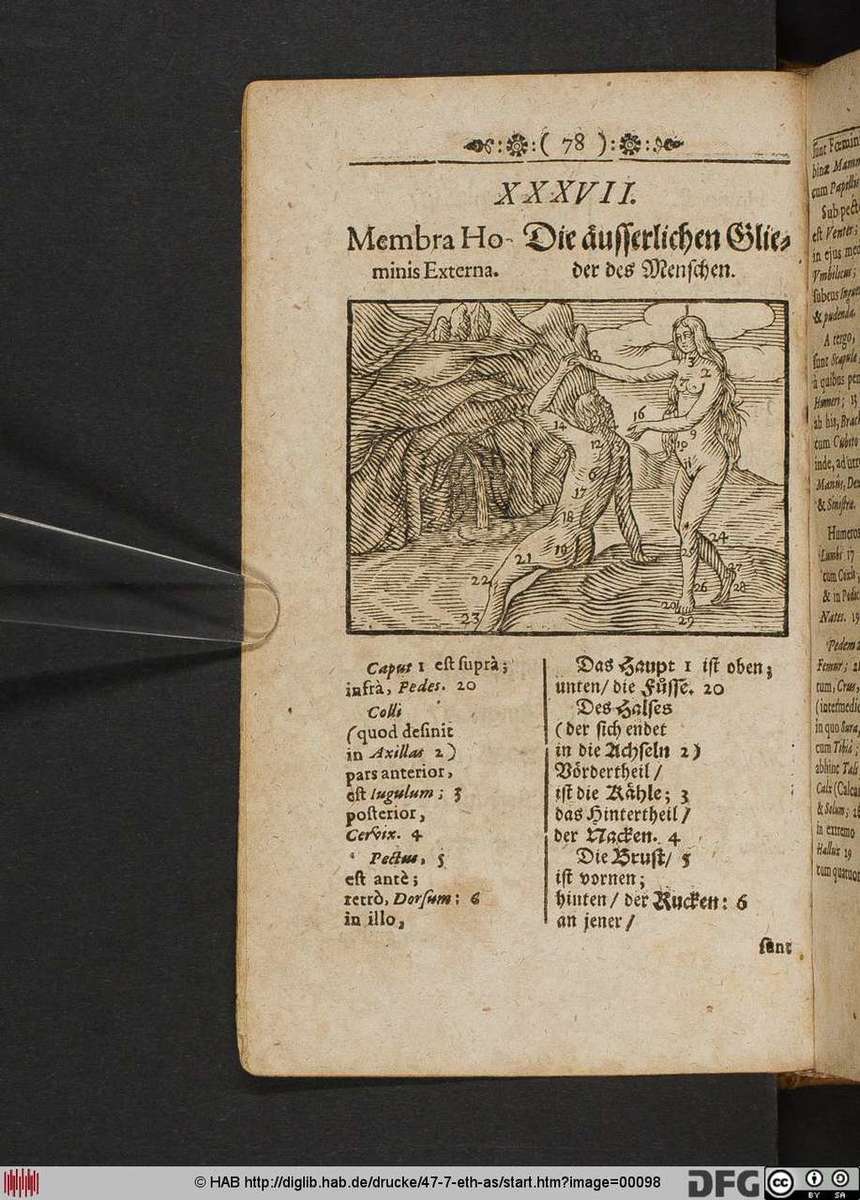
XXXVIII.
The Outward Parts of a Man.
The Head, 1. is above,
the Feet, 20. below
the fore part of the Neck
(which ends at
the Arm-holes, 2.)
is the Throat, 3.
the hinder part, the Crag, 4.
The Breast, 5, is before;
the back, 6, behind;
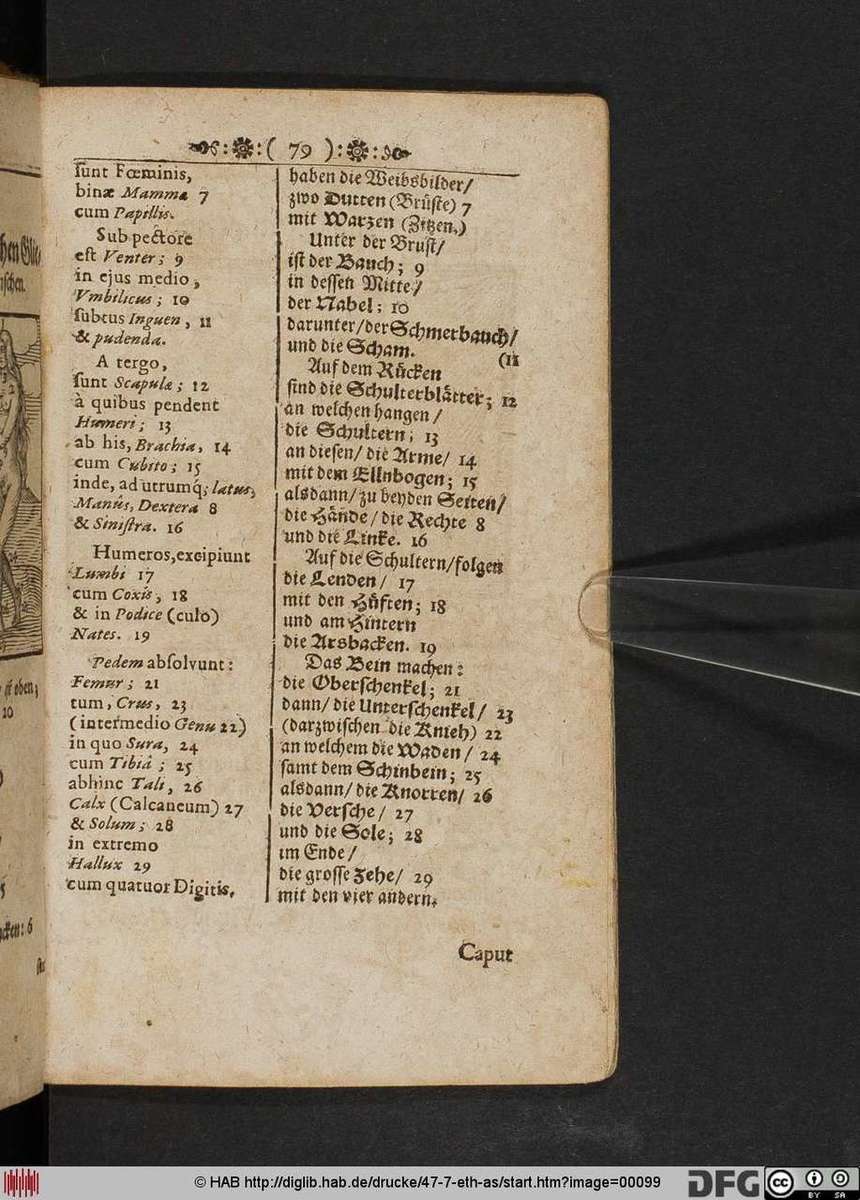
Women have in it
two Dugs, 7.
with Nipples,
Under the Breast
is the Belly, 9.
in the middle of it
the Navel, 10.
underneath the Groyn, 11.
and the privities.
The Shoulder-blades, 12.
are behind the back,
on which the Shoulders
depend, 13.
on these the Arms, 14.
with the Elbow, 15. and then
on either side the Hands,
the right, 8. and the left, 16.
The Loyns
are next the Shoulders,
with the Hips, 18.
and in the Breech,
the Buttocks, 19.
These make the Foot;
the Thigh, 21. then the Leg, 23.
(the Knee,
being betwixt them, 22.)
in which is the Calf, 24.
with the Shin, 25.
then the Ankles, 26.
the Heel, 27.
and the Sole, 28.
in the very end,
the great Toe, 29.
with four (other) Toes.
[ . . . ]
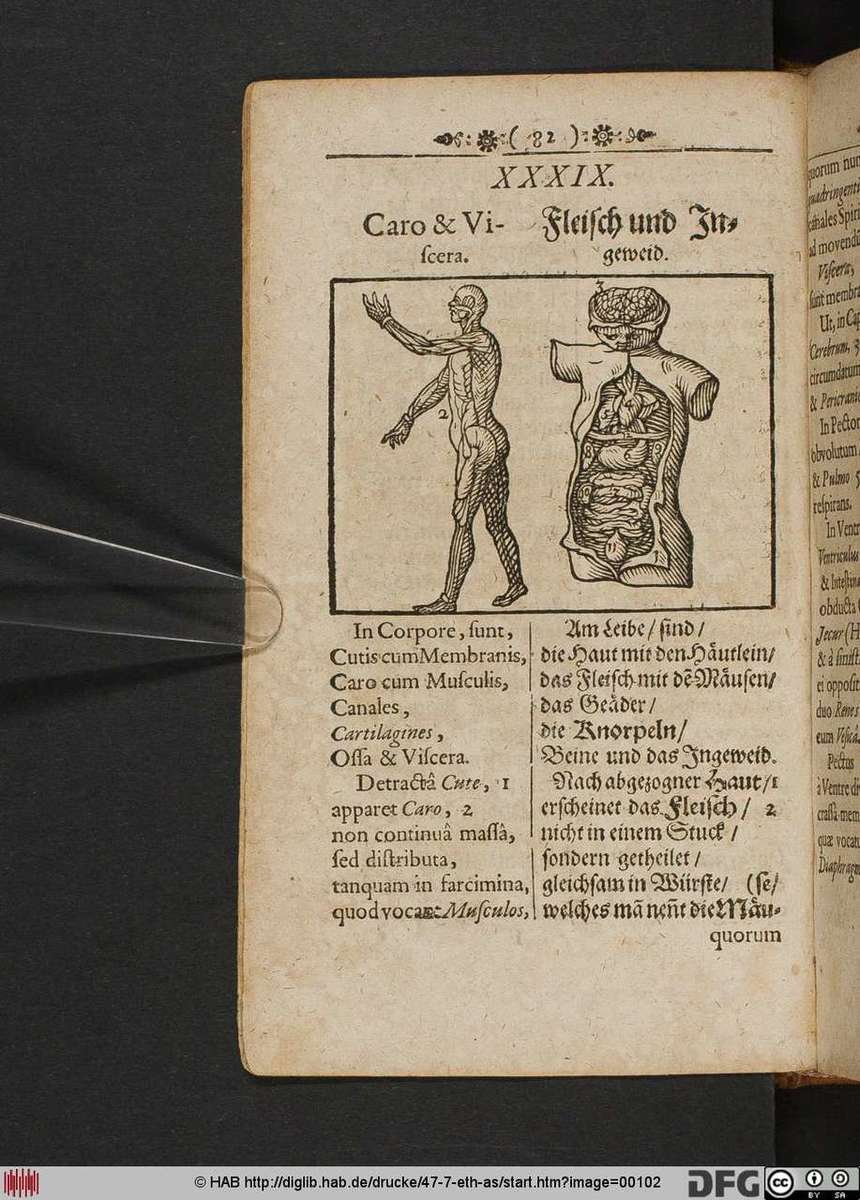
XXIXX.
The Flesh and Bowels.
In the Body are the Skin
with the Membranes,
the Flesh with the Muscles,
the Chanels,
the Gristles,
the Bones and the Bowels.
The Skin, 1. being pull’d off,
the Flesh, 2. appeareth,
not in a continual lump,
but being distributed,
as it were in stuft puddings,
which they call Muscles,
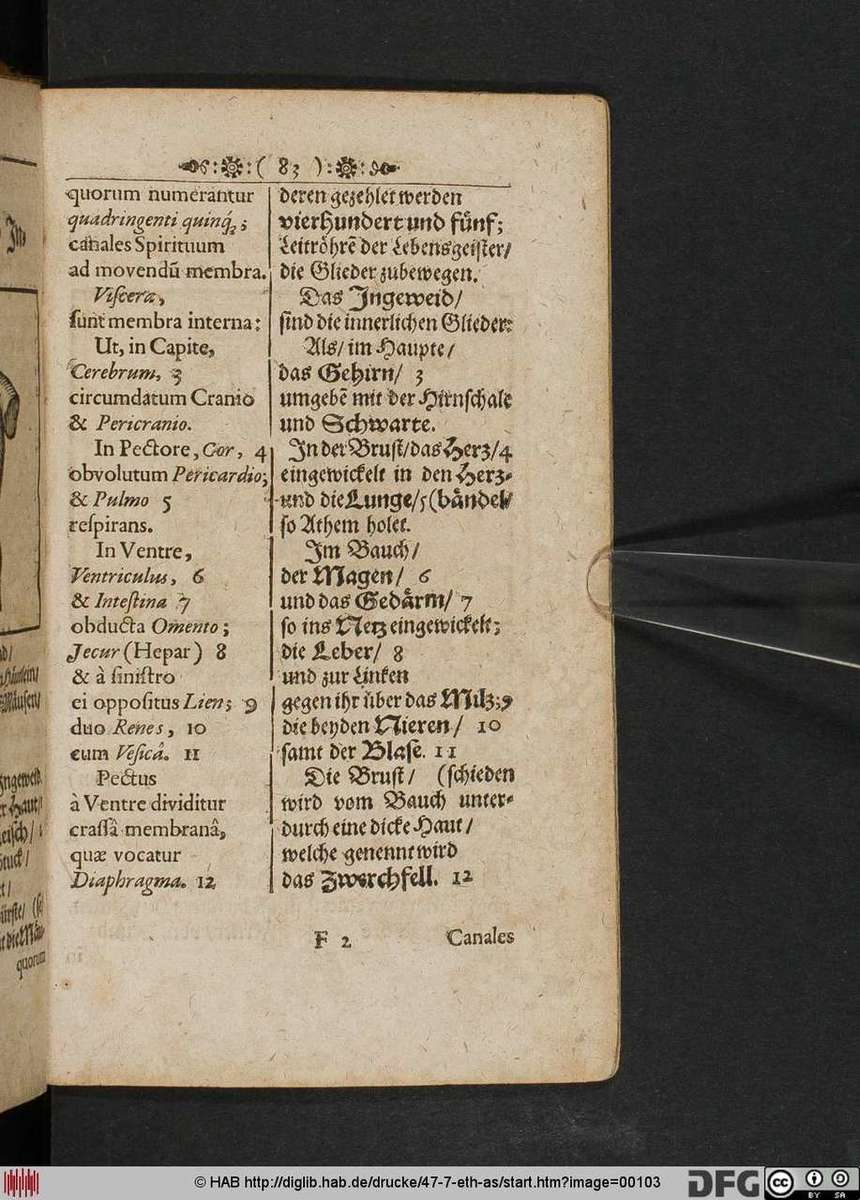
whereof there are reckoned
four hundred and five,
being the Chanels of the Spirits,
to move the Members.
The Bowels are
the inward Members.
As in the Head,
the Brains, 3.
being compassed about
with a Skull, and
the Skin which covereth
the Skull.
In the Breast, the Heart, 4.
covered with
a thin Skin about it,
and the Lungs, 5.
breathing to and fro.
In the Belly,
the Stomach, 6.
and the Guts, 7.
covered with a Caul.
The Liver, 8.
and in the left side opposite
against it, the Milt, 9.
the two Kidneys, 10.
and the Bladder, 11.
The Breast
is divided from the Belly
by a thick Membrane,
which is called the Mid-riff, 12.
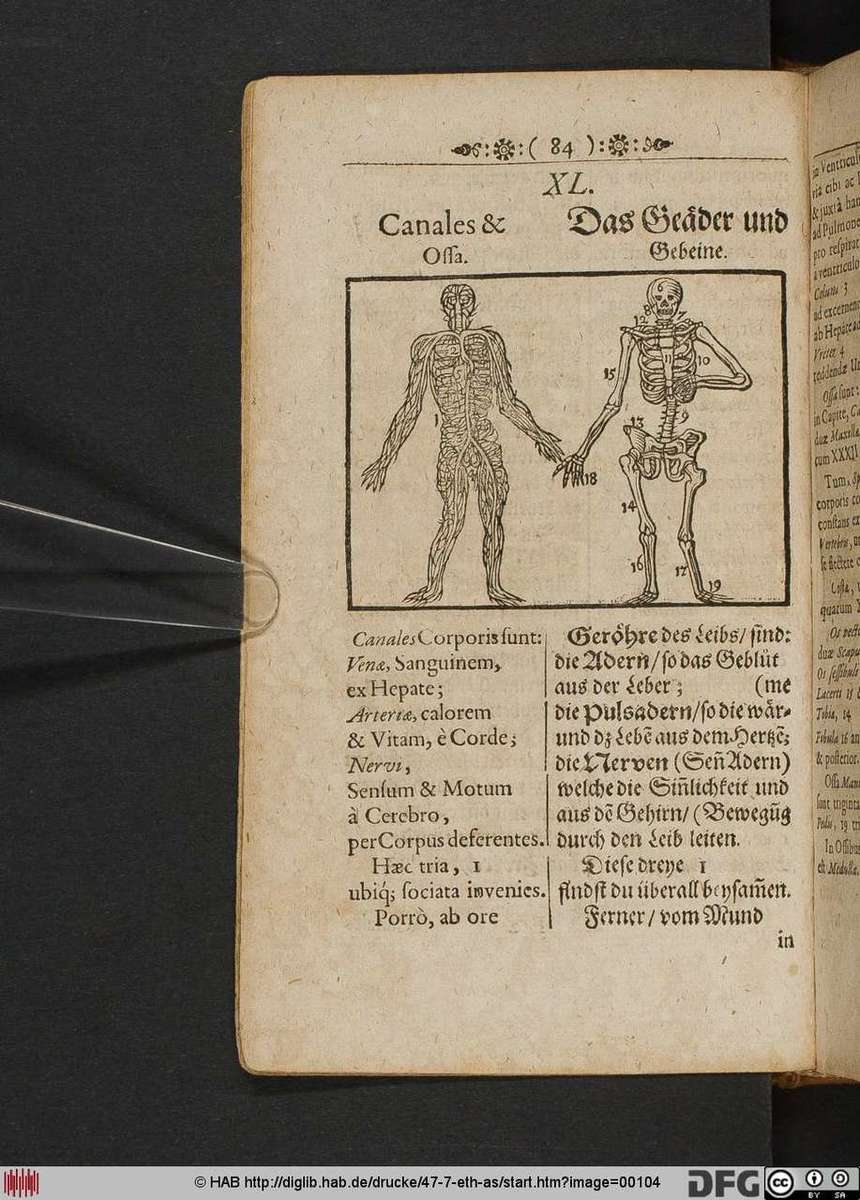
XLI.
The Chanels and Bones.
The Chanels of the Body are
the Veins, carrying
the Blood from the Liver;
The Arteries (carrying)
Heart and Life from the
Heat;
The Nerves (carrying)
Sense and Motion
throughout the Body from
the Brain.
You shall find these three, 1.
everywhere joined together.
Besides, from the Mouth
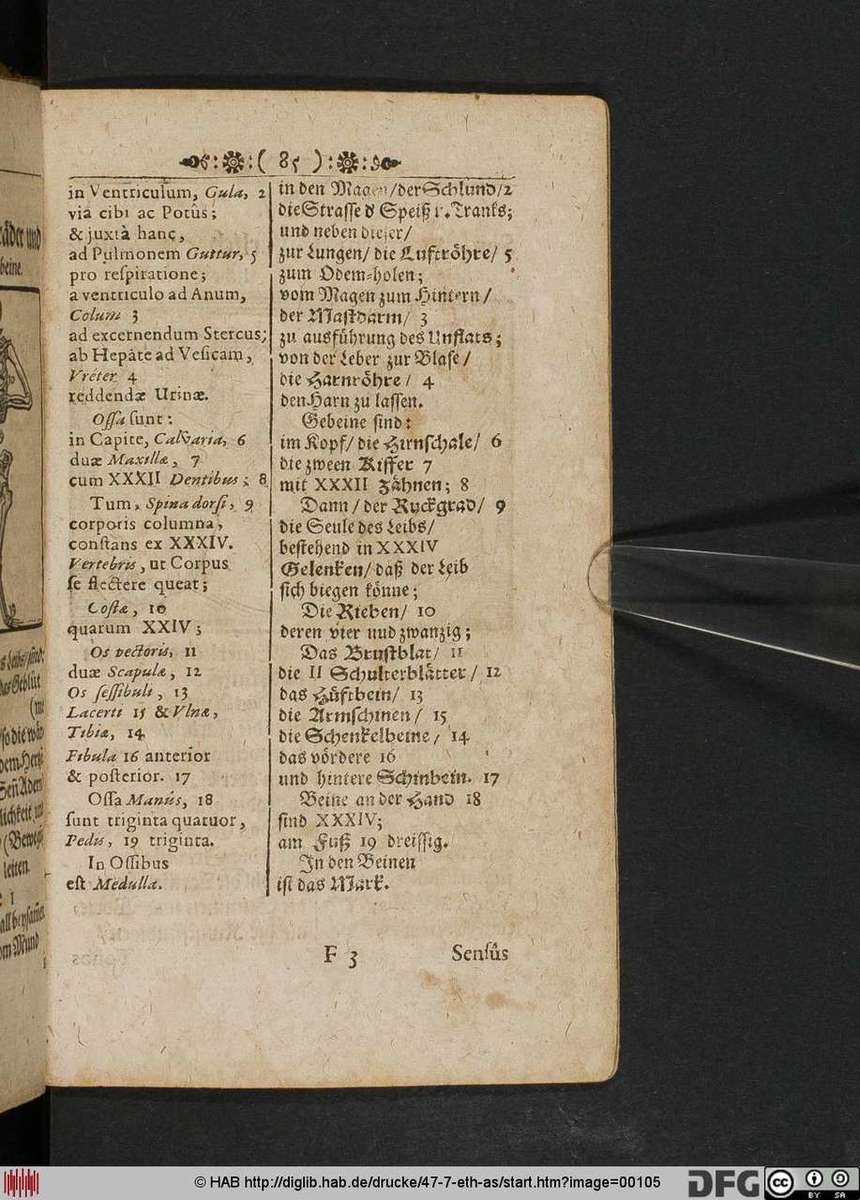
into the Stomach is
the Gullet, 2. the
way of the meat and drink;
and by it to the Lights, the
Wezand, 5. for breathing;
from the Stomach to the Anus
is a great Intestine, 3.
to purge out the Ordure;
from the Liver to the
Bladder, the Ureter, 4.
for making water.
The Bones are
in the Head, the Skull, 6.
the two Cheek-bones, 7.
with thirty-two Teeth, 8.
Then the Back-bone, 9.
the Pillar of the Body,
consisting of thirty-four
turning Joints, that the
Body may bend it self.
The Ribs, 10. whereof
there are twenty-four.
The Breast-bone, 11.
the two Shoulder-blades, 12.
the Buttock-bone, 13.
the bigger Bone
in the Arm, 15. and
the lesser Bone in the Arm.
The Thigh-bone, 14.
the foremost, 16.
and the hindmost Bone,
in the Leg, 17.
The Bones of the Hand, 18.
are thirty-four, and
of the Foot, 19. thirty.
The Marrow is in
the Bones.
[ . . . ]
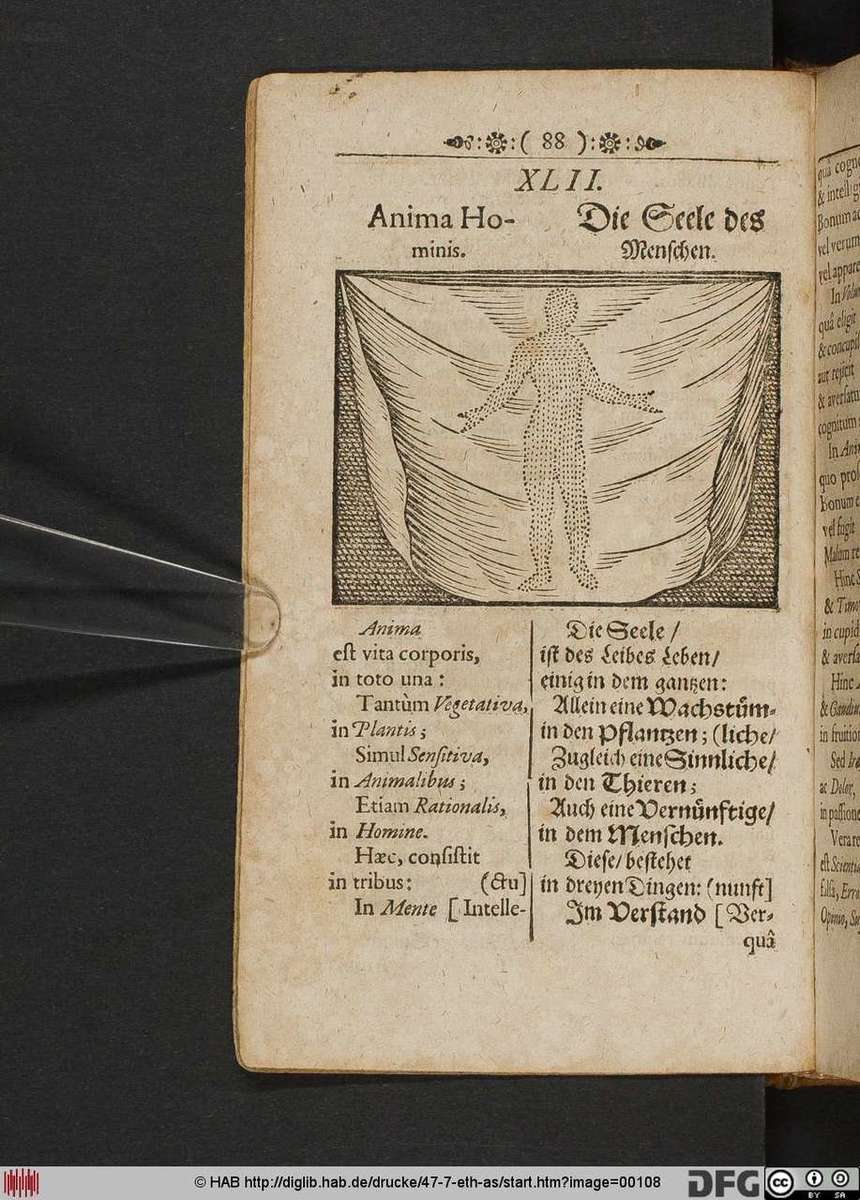
XLII.
The Soul of a Man
The Soul is the Life
of the Body, one in the whole.
Only Vegetative in Plants;
Withal Sensitive in
Animals;
And also rational in
Men.
This consisteth in three
things;
In the Understanding,

whereby it judgeth
and understandeth
a thing good and evil,
or true, or apparent.
In the Will,
whereby it chooseth,
and desireth,
or rejecteth, and
misliketh a thing known.
In the Mind,
whereby it pursueth
the Good chosen or
avoideth the Evil rejected.
Hence is Hope and Fear
in the desire,
and dislike.
Hence is Love and Joy,
in the Fruition:
But Anger and Grief,
in suffering.
The true judgment of a
thing is Knowledge;
the false, is Error,
Opinion and Suspicion.
[ . . . ]
Source of English translation (from the Latin): The Orbis Pictus of John Amos Comenius. Syracuse, NY: C.W. Bardeen Publisher, 1887. This edition is a faithful reprint of the original English translation: Joh. Amos Comenius’s Visible World: Or a Nomenclature, and Pictures of All the Chief Things that are in the World and of Mens Employment therein. Translated into English by Charles Hoole. London: John and Benjamin Sprint, 1728. Available online at: http://www.gutenberg.org/files/28299/28299-h/28299-h.htm
Source: Joh. Amos Commenii, Orbis Sensualium Pictus. Hoc est, Omnium fundamentalium in Mundo Rerum & in Vita Actionum Pictura & Nomenclatura = Die sichtbare Welt/ Das ist/ Aller vornemsten Welt-Dinge und Lebens-Verrichtungen Vorbildung und Benahmung. Latin-German. Noribergae [Nuremberg]: Endterus, 1658. Herzog August Bibliothek, Wolfenbüttel. Available online at: http://diglib.hab.de/drucke/47-7-eth-as/start.htm
This work is licensed under the Creative Commons Attribution-ShareAlike 4.0 License.